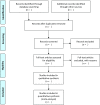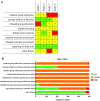A primer on systematic reviews in toxicology
- PMID: 28501917
- PMCID: PMC5489636
- DOI: 10.1007/s00204-017-1980-3
A primer on systematic reviews in toxicology
Abstract
Systematic reviews, pioneered in the clinical field, provide a transparent, methodologically rigorous and reproducible means of summarizing the available evidence on a precisely framed research question. Having matured to a well-established approach in many research fields, systematic reviews are receiving increasing attention as a potential tool for answering toxicological questions. In the larger framework of evidence-based toxicology, the advantages and obstacles of, as well as the approaches for, adapting and adopting systematic reviews to toxicology are still being explored. To provide the toxicology community with a starting point for conducting or understanding systematic reviews, we herein summarized available guidance documents from various fields of application. We have elaborated on the systematic review process by breaking it down into ten steps, starting with planning the project, framing the question, and writing and publishing the protocol, and concluding with interpretation and reporting. In addition, we have identified the specific methodological challenges of toxicological questions and have summarized how these can be addressed. Ultimately, this primer is intended to stimulate scientific discussions of the identified issues to fuel the development of toxicology-specific methodology and to encourage the application of systematic review methodology to toxicological issues.
Keywords: Evidence synthesis; Evidence-based toxicology; Narrative review; Review steps; Systematic review.
Conflict of interest statement
The contents of this manuscript are solely the responsibility of the authors and do not necessarily reflect the views or policies of their employers. Sebastian Hoffmann, a self-employed consultant, was paid by the Evidence-Based Toxicology Collaboration (EBTC) for his work on this manuscript. Nancy B. Beck was employed by the American Chemistry Council, a trade association of U.S. chemical manufacturers. Sebastian Hoffmann, Martin L. Stephens, John R. Fowle III, Ian Kimber, Nancy B. Beck, Rob de Vries and Katya Tsaouin are members of the Board of Trustees of the EBTC, which is funded by Center for Alternatives to Animal Testing at Johns Hopkins Bloomberg School of Public Health and ExxonMobil Foundation. Hubert Dirven, Julie E. Goodman, Manoj M. Lalu, Kristina Thayer, Paul Whaley and Daniele Wikoff are members of the Scientific Advisory Council of the EBTC. Manoj Lalu was supported by The Ottawa Hospital Anesthesia Alternate Funds Association.
Figures



Similar articles
-
Evidence-based toxicology: a comprehensive framework for causation.Hum Exp Toxicol. 2005 Apr;24(4):161-201. doi: 10.1191/0960327105ht517oa. Hum Exp Toxicol. 2005. PMID: 15957536
-
Assessing the comparative effects of interventions in COPD: a tutorial on network meta-analysis for clinicians.Respir Res. 2024 Dec 21;25(1):438. doi: 10.1186/s12931-024-03056-x. Respir Res. 2024. PMID: 39709425 Free PMC article. Review.
-
Systemic pharmacological treatments for chronic plaque psoriasis: a network meta-analysis.Cochrane Database Syst Rev. 2021 Apr 19;4(4):CD011535. doi: 10.1002/14651858.CD011535.pub4. Cochrane Database Syst Rev. 2021. Update in: Cochrane Database Syst Rev. 2022 May 23;5:CD011535. doi: 10.1002/14651858.CD011535.pub5. PMID: 33871055 Free PMC article. Updated.
-
Home treatment for mental health problems: a systematic review.Health Technol Assess. 2001;5(15):1-139. doi: 10.3310/hta5150. Health Technol Assess. 2001. PMID: 11532236
-
Cost-effectiveness of using prognostic information to select women with breast cancer for adjuvant systemic therapy.Health Technol Assess. 2006 Sep;10(34):iii-iv, ix-xi, 1-204. doi: 10.3310/hta10340. Health Technol Assess. 2006. PMID: 16959170
Cited by
-
Performance of preclinical models in predicting drug-induced liver injury in humans: a systematic review.Sci Rep. 2021 Mar 18;11(1):6403. doi: 10.1038/s41598-021-85708-2. Sci Rep. 2021. PMID: 33737635 Free PMC article.
-
A Systematic Review to Compare Chemical Hazard Predictions of the Zebrafish Embryotoxicity Test With Mammalian Prenatal Developmental Toxicity.Toxicol Sci. 2021 Aug 30;183(1):14-35. doi: 10.1093/toxsci/kfab072. Toxicol Sci. 2021. PMID: 34109416 Free PMC article.
-
Applying evidence-based methods to the development and use of adverse outcome pathways.ALTEX. 2021;38(2):336-347. doi: 10.14573/altex.2101211. Epub 2021 Apr 8. ALTEX. 2021. PMID: 33837437 Free PMC article.
-
A Survey of Systematic Evidence Mapping Practice and the Case for Knowledge Graphs in Environmental Health and Toxicology.Toxicol Sci. 2020 May 1;175(1):35-49. doi: 10.1093/toxsci/kfaa025. Toxicol Sci. 2020. PMID: 32096866 Free PMC article.
-
Artificial intelligence (AI)-it's the end of the tox as we know it (and I feel fine).Arch Toxicol. 2024 Mar;98(3):735-754. doi: 10.1007/s00204-023-03666-2. Epub 2024 Jan 20. Arch Toxicol. 2024. PMID: 38244040 Free PMC article. Review.
References
-
- AHRQ (2014) Methods guide for effectiveness and comparative effectiveness reviews. https://effectivehealthcare.ahrq.gov/ehc/products/60/318/CER-Methods-Gui.... Accessed 13 Feb 2017 - PubMed
Publication types
MeSH terms
LinkOut - more resources
Full Text Sources
Other Literature Sources

